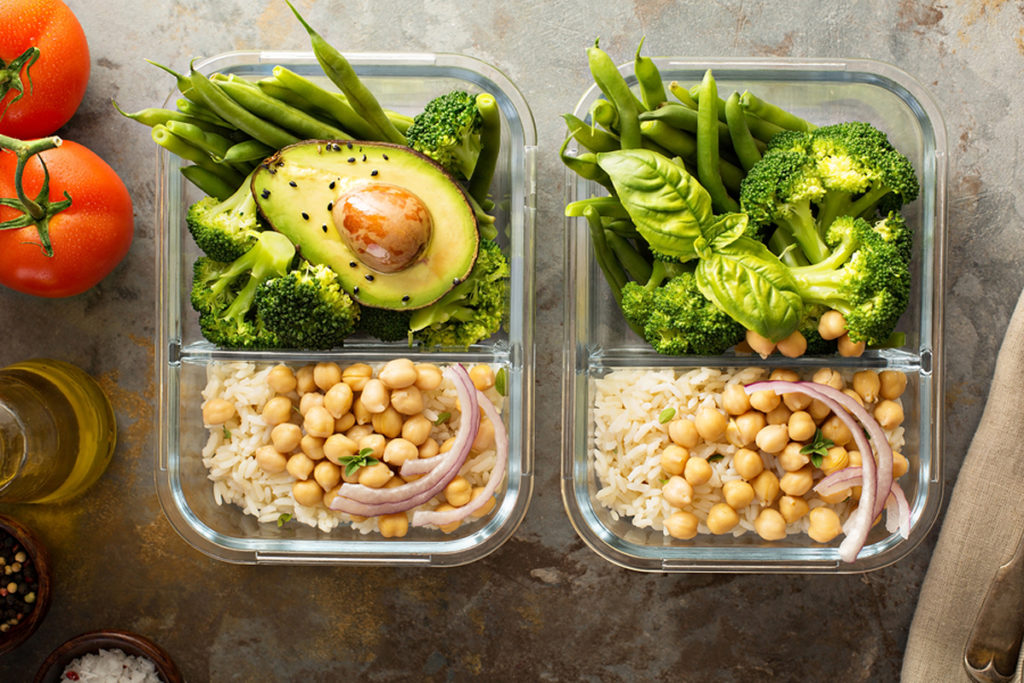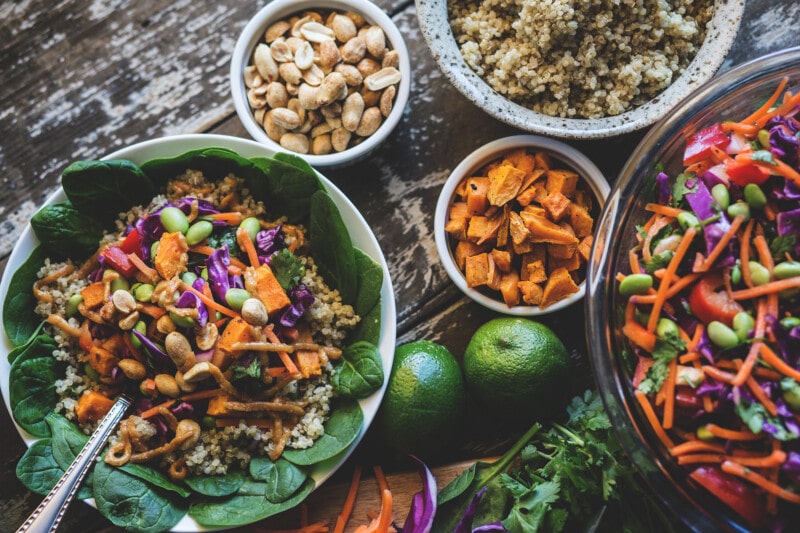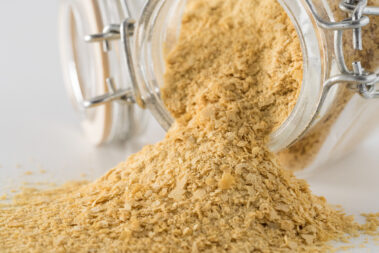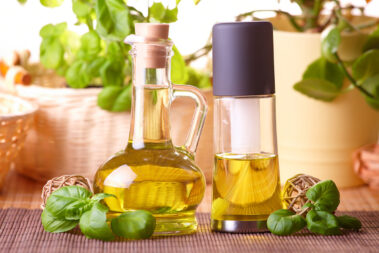A plant-based diet holds a lot of advantages, both for the one eating it and for the world around them. If you’re thinking about switching to a vegan or vegetarian diet, we have everything you need to get started.
Below, we define the different types of plant-based diets so you can find the right option for you. We also dive into the many benefits of eating plant-based and offer helpful tips, a sample 7-day menu, and recipe suggestions.
Let our guide for plant-based diet beginners help you find success with your new lifestyle.
Table of Contents
What Is a Plant-Based Diet?
The term “plant-based” is thrown around a lot these days. It can refer to a range of diet choices from hardcore vegan to flexitarian. All have one thing in common: they center around foods that come from the earth rather than foods that come from animals.
Below, we explain the four types of plant-based diets.
Vegetarian Diet
A vegetarian diet includes all food choices except for meat and fish. Vegetarians still eat dairy, eggs, and other animal products.
The term “vegetarian” defines what is not eaten more than what is. It’s possible to follow a vegetarian diet that consists largely of processed and fried food. That is to say, a vegetarian diet is not always healthier than traditional diet habits.
Vegan Diet
A vegan diet includes only plant-based foods. Vegans don’t consume animal products like milk, cheese, or eggs. Many vegans also abstain from animal-made ingredients like honey.
Most people following this diet try to avoid material products made from or by animals, as well. This includes leather, silk, and wool.
More so than vegetarianism, veganism is associated with a lifestyle type. Part of this lifestyle includes a focus on health and clean living. Some even take this to an extreme, eating only raw plant-based foods.
However, it’s possible to follow a standard vegan diet and still eat a lot of processed foods that aren’t great for your body.
Flexitarian
Flexitarian is a newer term used to describe someone who eats mostly vegetarian but occasionally indulges in meat or other animal products. Semi-vegetarians and pescatarians fall into this category.
This diet type is becoming more popular as people learn about the negative impacts eating meat has on people and the planet. It allows consumers to lessen their environmental impact and indulge in healthy options without completely depriving themselves of meat and animal products.
As with vegetarianism and veganism, flexitarians can eat predominantly whole-food options. Or they can indulge in more processed foods.
Whole-Food Plant-Based Diet
A whole-food plant-based diet is the most well-defined in terms of the quality of food consumed. This diet focuses on plant-based food items (read: vegan) that are as close to their whole, natural form as possible.
In terms of food quality, this diet is very restrictive. However, it’s less restrictive than typical veganism in that meat, dairy, eggs, and other animal products are to be limited, not avoided completely.
The degree to which animal products are included in this diet depends on the individual.

Benefits of a Plant-Based Diet
All plant-based diets offer some advantages over traditional eating. What percentage of the diet is made up of whole, plant-based foods determines how beneficial it is to you, the planet, and animals.
Health Benefits
Eating less meat and fewer animal products is associated with a range of health benefits. These benefits are exaggerated when a diet centers on quality whole foods rather than processed options.
Numerous studies have confirmed that eating plant-based increases heart health, helps with weight maintenance, reduces the risk of certain cancers and diseases, and improves your gut biome and immune health.
Supports Cardiovascular Health
Plant-based diets are naturally lower in cholesterol and saturated fats than traditional eating. They’re also higher in fiber and nutrients than the typical American diet. All of this works together to reduce your risk of heart disease.
Studies across various types of vegetarian diets have shown a 24% lower rate of coronary heart disease in plant-based eaters compared to omnivores. Men following a plant-based diet are 22% less likely to have a stroke than their meat-eating counterparts. Vegetarian diets have also been found to lower cholesterol, manage high blood pressure, and reduce the overall risk of cardiovascular event mortality(1).
For those already suffering from the ill effects of the American diet, switching to a plant-based diet can help improve your outlook.
Studies have shown that following a strict whole-food, plant-based diet can improve blood flow in the heart in as little as one month. And a year on the diet can reopen blocked arteries, effectively reversing severe cardiovascular disease(2).
Encourages Weight Loss
The vast majority of plant-based foods are lower in fat than meat, dairy, and eggs. Since fat has more than twice as many calories per gram as protein and carbohydrates, limiting it can instantly help lower your calorie intake. Combined with metabolism-boosting nutrients and loads of healthy fiber, a plant-based diet can help you reach your weight loss goals.
According to studies, vegetarians are less likely to be obese than omnivores. And every year on a vegan diet is associated with a 7% decrease in obesity risk. One study looking at weight loss in obese patients found that four weeks on a non-calorie-restrictive vegetarian diet led to an average weight loss of 7.5 pounds(3).
Reduces Type 2 Diabetes Risk
Metabolic disorders like type 2 diabetes are highly associated with the Western diet. The amount of saturated fat found in meat and the refined sugar used in processed foods seem to drive this trend. Whole-food, plant-based diets are low in saturated fat and refined sugars.
These characteristics appear to lower the risk of type 2 diabetes.
How much your risk is lowered is proportional to the type of diet you follow, according to studies. In non-vegetarians, the occurrence of diabetes is 7.6%. This drops to 6.1% in semi-vegetarians, 3.2% in full vegetarians, and 2.9% in vegans(4).
For those with type 2 diabetes, a whole-food, plant-based diet has proven effective in reversing the disease. Compared to those that follow a standard ADA diet, vegans are more likely to reduce their medication needs, lose weight, and lower their cholesterol. In one study, those on the standard ADA diet saw a 0.38-point drop in their A1C after 22 weeks, while those on a vegan diet saw a 1.23-point drop(5).
Supports Brain Health
Many factors of a plant-based diet that support heart and metabolic health seem to also support brain health.
One study found that long-term adherence to a plant-based diet resulted in better cognitive test scores in older adults. While the mechanism behind this isn’t well understood yet, it likely has something to do with the anti-inflammatory effects of vegan diets. Inflammation markers throughout the body in these individuals were lower than in non-vegan eaters(6).
Reduces Cancer Risk
Your risk of getting many cancers can be reduced through diet, according to the American Cancer Society. Eating a diet that restricts meat intake is associated with a lower risk of breast, colorectal, pancreatic, stomach, and lung cancer. Eating a whole-food, plant-based vegan diet also reduces your risks of prostate and endometrial cancer.
Not only are plant-based diets lower in fats and chemicals known to cause cancer, but they’re also loaded with anti-cancer compounds. Fruits, vegetables, whole grains, and legumes are packed with antioxidants that protect the body from cell damage and DNA mutation.
Additionally, vegan diets help people maintain a healthier weight. Since obesity is associated with an increased risk of many cancers, this alone can reduce your cancer risk.
Supports Immune Health
Scientific research continues to shed light on the important connection between gut health and immunity.
Seventy percent of your immune system is in your gut. The microbes there communicate with white blood cells and other immune cells to launch attacks against invaders. These same beneficial bacteria help maintain a baseline of health by consuming and crowding out harmful bacteria and yeast.
High-fiber diets, which include plant-based options, are associated with a lower occurrence of digestive problems. They also support a stronger, more diverse gut biome.
Furthermore, many foods consumed by plant-based connoisseurs are high in prebiotic material and living probiotics. The most obvious of these are kimchi and kombucha. But simpler plant-based foods like beans and oats also support biome health and, by extension, the immune system.
Environmental Benefits
Eating plant-based doesn’t just make you healthier, it also helps our planet stay healthier.
Animal agriculture releases more greenhouse gasses into the atmosphere than the entire transportation sector combined(7). And it’s responsible for 90% of US water consumption and is the leading cause of species extinction and ocean dead zones(8, 9).
Doing your part for the planet is as easy as reducing your meat, dairy, and egg consumption. Or, if you really want to make a difference, give up animal products altogether.
Ethical Benefits
Long before the health and environmental impacts of meat eating were well known, people were giving up animal products for the sake of the animals.
Over 55 billion animals are killed for their meat in the US every year. This number doesn’t take into account the millions of chicks and calves culled as part of the egg and dairy industry. And it doesn’t include the wolves, bears, coyotes, and smaller predators killed to protect livestock investment.
This one’s fairly simple: Without a demand for animal products, there is no profit in the exploitation or death of animals.
Financial Benefits
While it’s possible to spend a pretty penny on fancy avocado toast and commercial meat and dairy alternatives, eating plant-based isn’t inherently expensive. In fact, studies have shown that going vegetarian or vegan will actually save you money—about $0.77 per meal on average.
If saving money on groceries is important to you, there are ways to stretch these savings even more. Going vegan on a budget is simple if you focus on shelf-stable whole foods and in-season or frozen produce.

Tips for Starting Plant-Based
In theory, going plant-based is simple. All you need to do is skip the meat, dairy, and eggs. But if you want the transition to be smoother and the change to last, there are some things you should do.
From adding a probiotic to the mix early on to getting out of your culinary comfort zone, these tips will help you switch to and stick with a plant-based diet.
Ease Into It
For most people coming off a traditional American diet, it can be a little uncomfortable switching to plant-based. And I’m not just talking about emotional discomfort.
Plant-based foods are higher in fiber than meat and processed foods. This is one thing that makes this diet so healthy. But if your stomach isn’t used to it, things can get messy fast.
I’m talking about gas, diarrhea, and constipation.
One way to help ease this discomfort is to ease into the diet. Start by going vegan for one meal a day. Then slowly increase your vegan meal intake over the course of a few weeks.
This will give your digestive tract and your gut biome time to change and adapt to healthier foods. Adding a probiotic supplement to your routine can help speed up this process.
Focus on Variety
Many people switching to a vegetarian diet are worried about meeting all their nutritional needs. The truth is, plants have everything your body requires to thrive. But only if you eat a variety of different foods.
(For the record, the same is true of any type of diet.)
Eating a wide range of plant foods ensures you get all the vitamins, minerals, amino acids, and macronutrients you need. Not only should you switch up which veggies and fruits you eat with each meal, but also the grains, legumes, and nuts.
There are a wide variety of delicious and nutritious animal-free foods out there. So there is no reason to limit yourself to the same bland, boring meals every week.
Plant-Based Nutrient Supplementation
While a well-planned plant-based diet can meet the majority of your nutritional needs, certain supplements do have a role. A diet that excludes animal products should include regular supplementation of vitamin B12, which is critical for red blood cell health. Additionally, most people worldwide are vitamin D insufficient, vegan or not. Get your blood levels checked before adding a vitamin D supplement to determine whether a maintenance dose is enough or a higher dose is needed to correct low levels first. Finally, an omega-3 supplement can provide EPA and DHA directly for people who don’t consume fish.
Use Decadent Whole-Food Recipes to Satisfy Cravings
Plant-based eating doesn’t mean eating like a rabbit. Even if you’re following a whole-food, plant-based diet, there are ways to create decadent meals.
With the right tools and little know-how, you can create delicious whole-food vegan cheese sauces, burgers, and desserts right at home.
Adding these kinds of meals to your repertoire will help alleviate vegan burnout. They’re also great choices for helping convert your non-vegan friends into adopting healthier eating habits.
Mix Things Up
No matter what diet you follow, it’s easy to get stuck in a rut making the same meals over and over. Doing this with a vegan diet may leave you reaching for appealing animal-based products to help spice things up.
Rather than giving in to that desire, try stepping out of your comfort zone to mix up some new flavors. It’s possible to find plant-based recipes representing just about every global cuisine. Dabbling in Indian, Ethiopian, Mexican, and other options can help you find new flavor and spice combinations to reinvigorate your cooking.
Be Aware of Hidden Animal-Based Ingredients
If you’re going “mostly” plant-based, then there are no ingredients that are strictly off-limits. But if you want to fully embrace the vegan code, then you’ll want to know which foods contain hidden animal ingredients.
Refined sugar, most wines, and dijon mustard all use animal products during processing. Even some products you’d think were safe, like bananas, orange juice, and bagels, often aren’t. You can learn more about these and many other surprisingly non-vegan foods here.
What to Eat on a Plant-Based Diet

There’s an almost unlimited supply of plant-based ingredients out there. But when you’re just getting started, it can be hard to see all of them. One simple way to visualize your options is to break them down into categories: food to target, foods to limit, and foods to avoid.

Easy Vegan Veggie Pasta
Ingredients
- ½ lb penne pasta
- ½ cup reserved pasta cooking liquid
- 4 oz mushrooms
- 1 cup cherry tomatoes
- 2 bell peppers
- 2 tbsp olive oil split
- ¼ cup basil
- ¼ tsp salt
- ¼ tsp black pepper
- vegan parmesan for topping
Instructions
- Bring a pot of water to a boil and cook pasta according to package directions.
- Slice the mushrooms and cut the tomatoes in half. Dice the bell peppers and roughly chop the basil.
- Heat up a saute pan and add 1 tbsp of olive oil. Add the mushrooms and cook for 2 minutes. Then add the bell peppers to the pan and continue to cook for about 5 minutes or until the water from the mushrooms has mostly evaporated. Last, add the tomatoes and cook for about 2 minutes, or until fragrant.
- Turn off the heat and add the cooked and drained pasta to the pan along with the chopped basil and ¼ to ½ cup reserved cooking liquid (enough to coat) plus 1 tbsp olive oil.
- Toss to mix everything together and coat the pasta in oil. Finish with salt, pepper, and vegan parmesan.
Notes
- Substitute any vegetables you’d like. Asparagus, spinach, peas, broccoli, zucchini, and yellow squash all make great additions.
- Substitute gluten-free pasta if needed.
Nutrition
Whole Foods to Target
Whether you’re going whole-food plant-based or just mostly vegetarian, your target foods will be the same. These options pack tons of nutrition and are full of health-supporting phytonutrients and antioxidants. As long as you’re getting enough variety, you really can’t overdo it with any of these options.
- Vegetables
- Fruits
- Whole Grains
- Lentils
- Beans
- Nuts
- Tubers (Potatoes, Turnips, etc.)
- Seeds
- Nutritional Yeast
- Spices
- Tea
Many of these target foods are pantry staples with long shelf lives. Keeping them on hand will make cooking easier.
Fresh produce is the most nutritious, but frozen options are good to have for those busy weeknight meals. And vegan go-to’s like nutritional yeast, cashews, and certain spices are a must for recreating decadent meals using whole-food ingredients.
And don’t forget to include plenty of plant-based proteins in your diet. Black beans, soy, almonds, and other high-protein foods will help you feel energized and keep cravings at bay. For your important omega fatty acids, be sure to eat walnuts, chia seeds, or flaxseeds every day.
Foods to Limit
How much you want to limit the following foods really depends on what you hope to gain from your plant-based diet. The more you can avoid these and stick to the above list, the better. But indulging occasionally isn’t likely to have a huge impact on your health.
- Meat
- Fish
- Eggs
- Milk, Butter, and Dairy
- Processed Meat and Cheese Alternatives
- Refined Oils
- Honey
- Gelatin
Many of the above can be substituted for easy-to-make vegan alternatives. For more information, check out these helpful articles:
- Best Vegan Egg Substitutes
- Best Vegan Heavy Cream Substitutes
- Best Vegan Meat Substitutes
- Best Vegan Greek Yogurt Substitutes
- Best Vegan Gelatin Substitutes
Foods to Avoid
Whether you’re following a plant-based diet or not, there are some foods we would all be better off completely avoiding. Here are the foods you should start phasing out of your diet for better health.
- Refined sugar
- Highly processed food

One Week Sample Menu
So how do you put your target foods to use to make delicious plant-based meals? We have a few ideas to get you started.
Below, you’ll find our sample 7-day plant-based meal menu to help you put your new diet into action.
This menu dives right in with 100% vegan recipes for breakfast, lunch, and dinner. If you want to take it slower, simply pick one meal each day and stretch the menu over the course of a few weeks until you’ve hit them all.
Day 1
Breakfast: Vegan Breakfast Sandwich
Lunch: Vegan Taco Salad with Homemade Dressing
Snack: No Bake Carrot Cake Protein Bars
Dinner: Quick and Easy Vegan Pad Thai
Day 2
Breakfast: Vegan Breakfast Hash
Lunch: Chickpea Salad Sandwich
Snack: Roasted Rosemary and Herb Crackers with Creamy Vegan Spinach and Artichoke Dip
Dinner: Vegan Eggplant Parmesan
Day 3
Breakfast: Ultimate Vegan Breakfast Smoothie with Flaxseed and MCT
Lunch: Vegan Grilled Cheese
Snack: Roasted Sugar Snap Peas
Dinner: Wild Rice Stuffed Acorn Squash
Day 4
Breakfast: Scrambled Tofu Breakfast Burrito with Bell Pepper and Red Onion
Lunch: Kale and Quinoa Salad with Lemon Vinaigrette
Snack: Vegan Pumpkin Cream Cheese Muffins
Dinner: Vegan Pot Pie with Puff Pastry
Day 5
Breakfast: Vegan English Breakfast
Lunch: Vegan BLT with Smokey Tempeh
Snack: Crispy Dry Roasted Chickpeas
Dinner: Thai Sweet Potato Curry with Brown Rice
Day 6
Breakfast: Vegan French Toast
Lunch: Vegan Spring Rolls with Peanut Sauce
Snack: Easy Vegan Protein Cookies
Dinner: Vegan Mac & Cheese with Nutritional Yeast
Day 7
Breakfast: Mandarin Orange Smoothie Bowl with Chia Seeds
Lunch: Pesto and Red Pepper Sandwich
Snack: Fresh Veggies and Roasted Beet Hummus
Dinner: Vegan Hemp Power Bowl
FAQ
What foods should I avoid on a plant-based whole-food diet?
When eating a plant-based diet you want to avoid any foods that come from animal sources. This includes meat, dairy, and eggs. You also want to limit the amount of refined foods you eat, including oils and heavily processed foods.
Is peanut butter OK on a plant-based diet?
Yes, peanut butter and other nut butters are a healthy part of a plant-based diet. Opt for natural brands or homemade and be sure to avoid products that contain added ingredients such as palm oil, sugar, or molasses.
Are eggs allowed on a plant-based diet?
Technically, yes. Plant-based diets focus on limiting certain foods rather than restricting them completely. So, you can eat eggs as part of a plant-based diet, but they should not be a primary source of protein or an ingredient frequently used in meals.
More Resources for Plant-Based Success
Looking for more resources to help you on your plant-based journey? You’re in the right spot!
Here at Clean Green Simple, you’ll find information on the best kitchen tools for vegans and recipe roundups for endless inspiration. We’ve also got educational articles written by our in-house nutritionists and plant-based experts to help you make the right decisions for your health.
And when you’re ready to take your plant-based lifestyle to the next level, take a look at our homegrown vegetable guides, product recommendations, and how-to guides.
How is your plant-based journey going? Share your experience and let us know what questions you have by posting in the comments section below.
- How to Pick the Perfect Watermelon For a Sweet Summer Treat - April 10, 2024
- Future Kind’s Foundations: A Multivitamin Made for Vegans - December 5, 2023
- Does Nutritional Yeast Go Bad? - November 28, 2023








